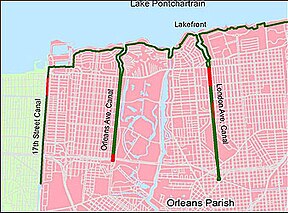| New Orleans Outfall Canals | |
|---|---|
 The primary outfall canals in New Orleans: the 17th Street, Orleans Avenue, and London Avenue canals. | |
| Location | New Orleans, Louisiana |
| Country | United States |
| Specifications | |
| Length | 13 miles (21 km) |
| Locks | Interim and permanent gated closure structures installed post-Katrina |
| Status | In operation |
| Navigation authority | U.S. Army Corps of Engineers |
| History | |
| Principal engineer | U.S. Army Corps of Engineers |
| Date completed | 19th century (original construction) |
| Date restored | Post-Hurricane Katrina remediation completed in 2011 |
| Geography | |
| Start point | Various pump stations in New Orleans (Pump stations include Pump Station 6 (17th Street Canal), Pump Station 7 (Orleans Avenue Canal), and Pump Station 3 (London Avenue Canal)) |
| End point | Lake Pontchartrain (Canals discharge into Lake Pontchartrain) |
There are three outfall canals in New Orleans, Louisiana – the 17th Street, Orleans Avenue and London Avenue canals. These canals are a critical element of New Orleans’ flood control system, serving as drainage conduits for much of the city. There are 13 miles (21 km) of levees and floodwalls that line the sides of the canals. The 17th Street Canal is the largest and most important drainage canal and is capable of conveying more water than the Orleans Avenue and London Avenue Canals combined.[1]
The 17th Street Canal extends 13,500 feet (4,100 m) north from Pump Station 6 to Lake Pontchartrain along the boundary of Orleans and Jefferson parishes. The Orleans Avenue Canal, between the 17th Street and London Avenue canals, runs approximately 11,000 feet (3,400 m) from Pump Station 7 to Lake Pontchartrain. The London Avenue Canal extends 15,000 feet (4,600 m) north from Pump Station 3 to Lake Pontchartrain about halfway between the Orleans Avenue Canal and the Inner Harbor Navigation Canal (also known locally as the Industrial Canal).[2]
- ^ J. David Rogers, G. Paul Kemp (2015). "Interaction between the US Army Corps of Engineers and the Orleans Levee Board preceding the drainage canal wall failures and catastrophic flooding of New Orleans in 2005". Water Policy. p. 712. Retrieved 2018-02-25.
- ^ United States Army Corps of Engineers (2009). "Draft Individual Environmental Report: Permanent Protection System for the Outfall Canals Project on 17th Street, Orleans Avenue, and London Avenue Canals" (PDF). United States Army Corps of Engineers. p. 69. Retrieved 2016-01-20.